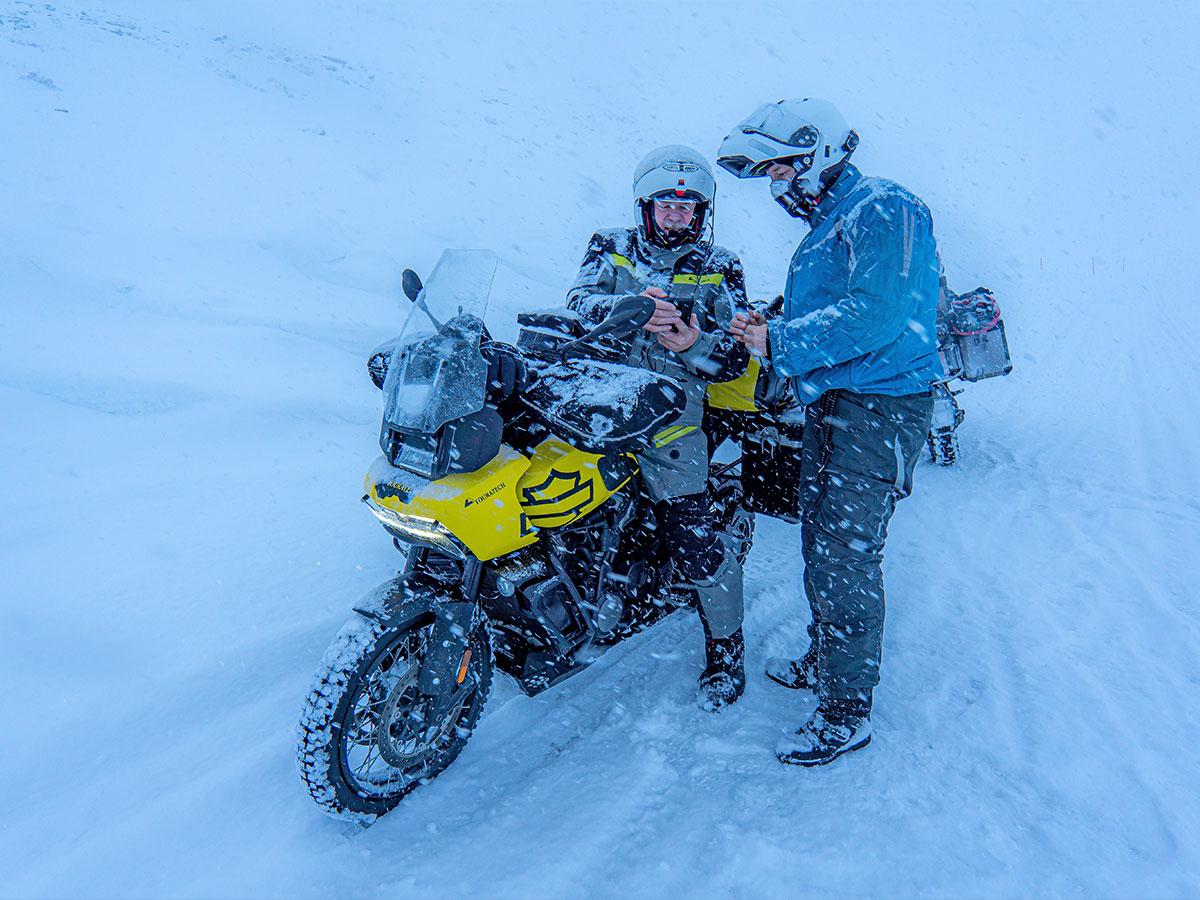71° 10′ 21″ North, 25° 47′ 4″ East, these are the coordinates of the North Cape. This point in the far north of Europe is the dream destination of many motorcyclists. But certainly not in winter. Andreas Hülsmann (text and photos) and Rainer Krippner (photos) set out in the cold and snow to reach this magic point in frosty conditions.
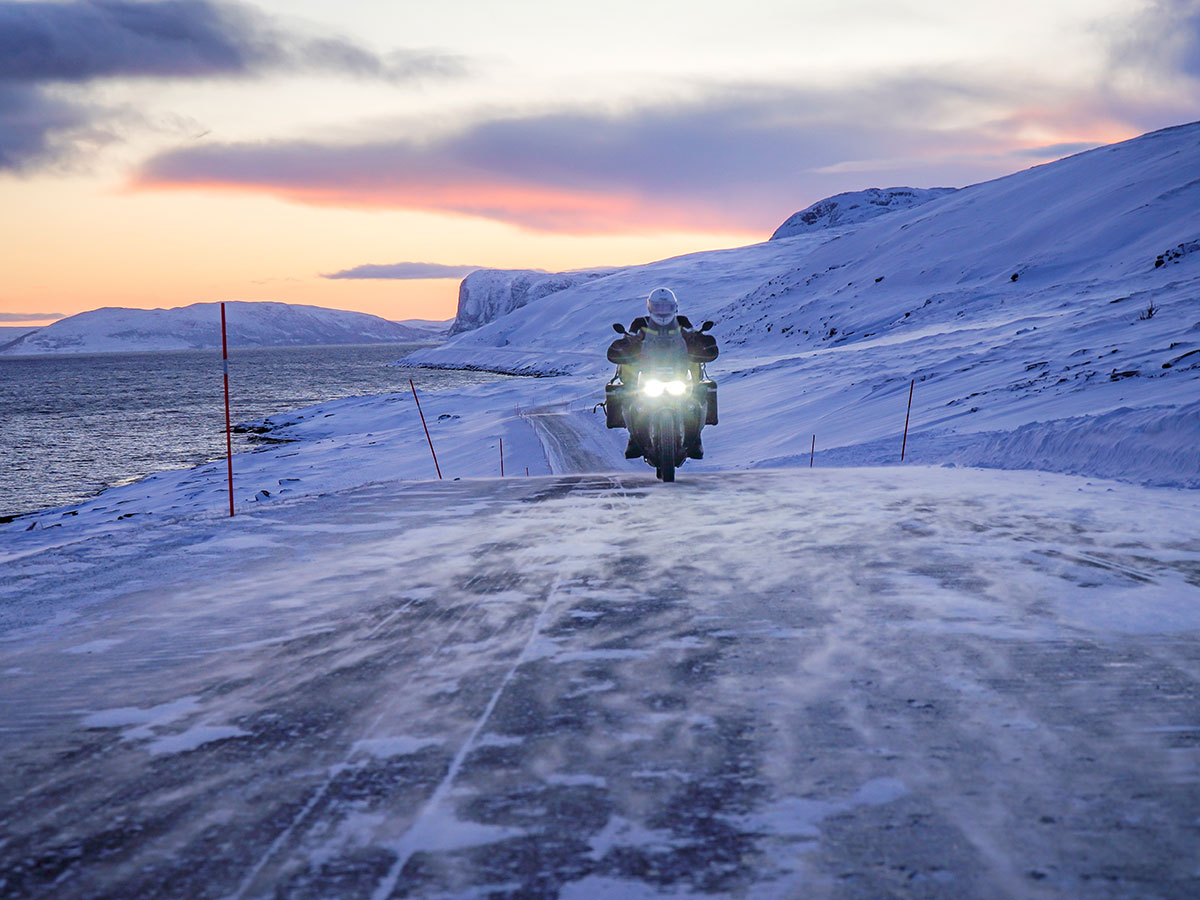
We just can't get out of Lakselv. Outside it's minus 18 degrees Celsius, so far we've had it warm, with the small electric heater in the hut managing to warm the air to 24 degrees. Rainer and I actually wanted to leave this cosy atmosphere behind us long ago, but at the moment we're stuck here. Rainer's Harley is playing up. The Pan Am does not like the uncivilised minus 18 degrees. There's no question that the V2 is trying hard, and time and again we can wrest a few turnovers from her – but it's not enough for a continuous run. My Ténéré can't manage to provide enough power for the 1250cc engine. It's only with the energetic support of a 4WD that the American lady manages to pick up momentum.
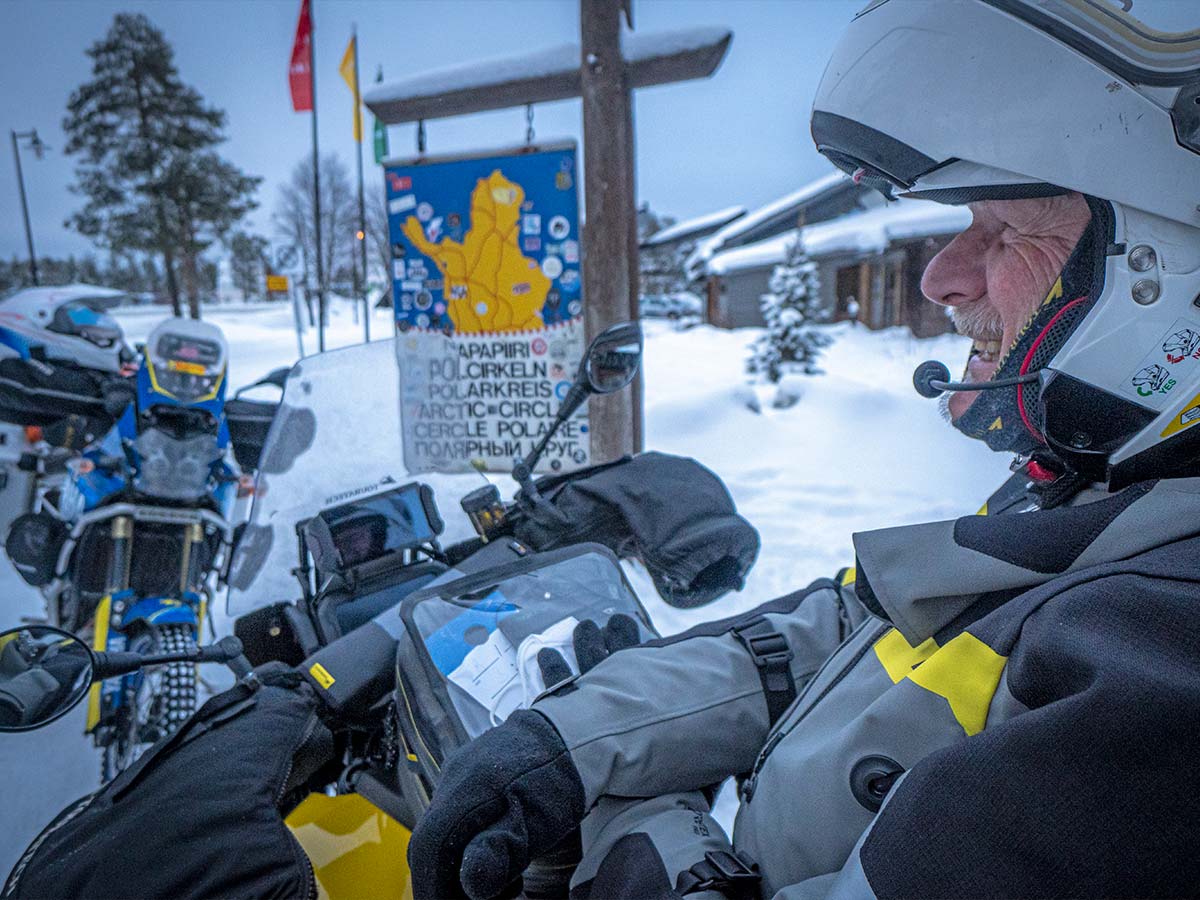 First ferry, then car train – up to Rovaniemi the tour was quite comfortable, from the Arctic Circle towards the North Cape it's all icy roads
First ferry, then car train – up to Rovaniemi the tour was quite comfortable, from the Arctic Circle towards the North Cape it's all icy roads
Driving with spikes on bare asphalt is no fun
It took us six days to get to Lakselv on our motorcycles. Actually a remarkable pace in these icy conditions, but we didn't ride this route on our motorcycles alone. Our journey on two wheels only began at the Finnish Arctic Circle in Rovaniemi. Until then, the tour had been very relaxed. The Finnlady of the Finnlines shipping company took us across the Baltic Sea to Helsinki in one day and two nights, almost like being on a cruise. From the Finnish capital, we continued overnight by car train to Rovaniemi. Rainer and I had already travelled this route north five years ago. Back then, we'd started from Helsinki with my sidecar motorcycle and a BMW XChallenge and taken two and a half days to cover the 850-kilometre route to the Arctic Circle. We didn't want to waste this time again just getting the kilometres behind us. Besides, riding with spikes on bare asphalt doesn't have much to do with ride pleasure.
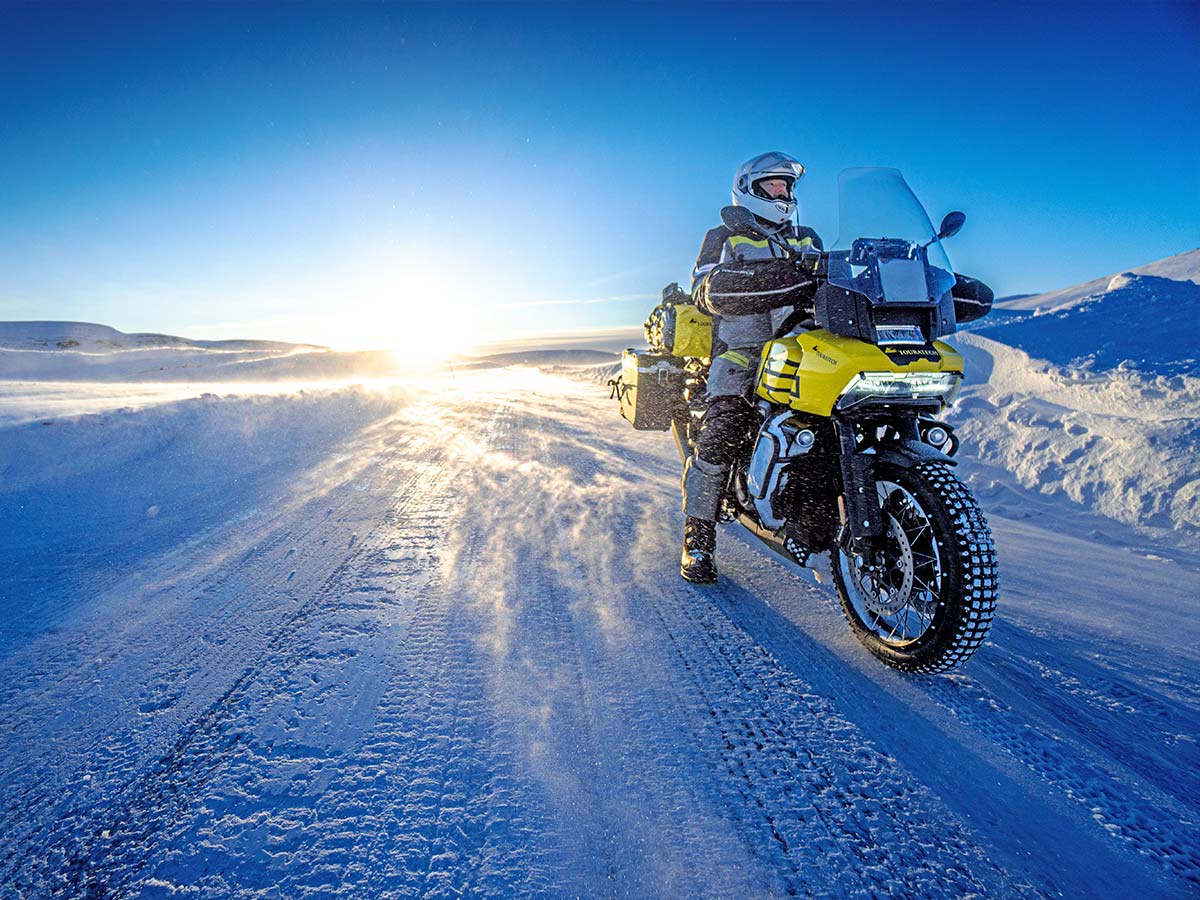
The weather is still good, but the next stormy depression with strong winds is already on the horizon
The window of high pressure will only be open for a short time
Our detour to Santa's residence on the Arctic Circle is brief. And just one day later, after 550 kilometres via Inari and Karassjok, we land in Lakselv. The North Cape is within reach, but we have to really hit the road if we want to get anywhere near this magical place. Daylight is scarce up here at this time of year. The Pan America as well as the Ténéré have slowly warmed up. But we're not really making much progress. Behind almost every second bend we come across a fascinating spot, with the low sun enveloping the landscape in a very special light.
It's not until around two in the afternoon that we reach Olderfjord, having covered just under 70 kilometres. The late start in Lakselv and the photo stops have cost us time. It's still 130 kilometres to the cape and they certainly can't be done today. But we have to get as close as possible to the coordinates of 71° 10' 15.431" north latitude and 25° 47' 1.176" east longitude, because the weather forecast predicts a window of high pressure for tomorrow morning, but it's not going to be open for very long.
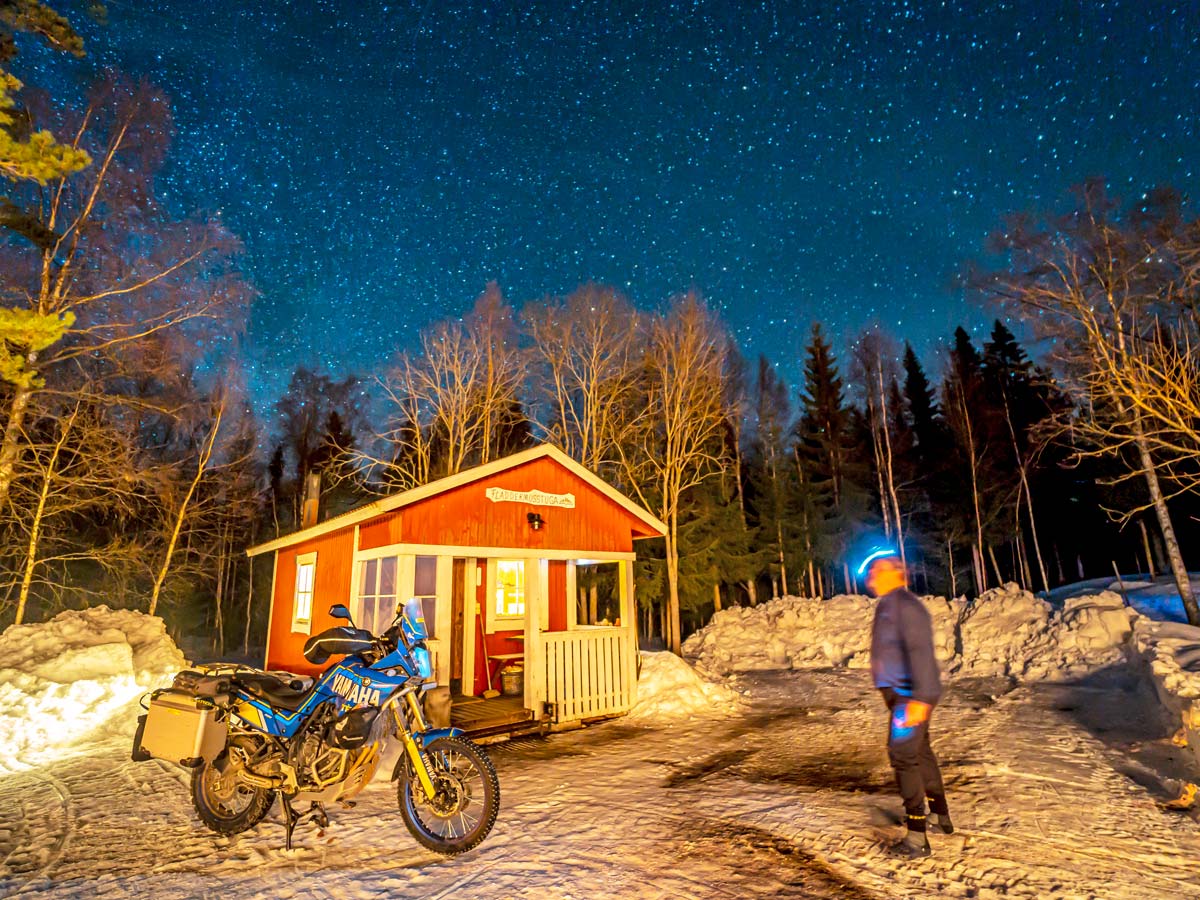 The sky is full of stars. Despite the good conditions, there are no northern lights to be seen
The sky is full of stars. Despite the good conditions, there are no northern lights to be seen
We navigate from one marker post to the next
It gets harder to move forward with every kilometre. An opaque mass of snowflakes is dancing in front of my visor. Visibility has dropped to almost zero. Rainer and I work our way forward from one marker post on the side of the road to the next. The storm is getting more violent. The ride through the tunnel that leads across to the island of Magerøya, where the North Cape is located, is almost relaxing. We pass Honningsvåg, the largest town on North Cape Island. Despite the conditions, we set our sights on Skarsvåg, a small cluster of houses just a few kilometres from the cape. According to the search engine, there are three accommodation possibilities there, two of which are open all year round – or so the smartphone tells us. But the analogue facts present us with a different reality. Nothing is open. Are we going to give up the hard-won kilometres from Honningsvåg to Skarsvåg and retreat? No, Rainer and I quickly agree that that's not an option. The snowflakes dancing wildly in the wind obscure the light cast into the night by the street lamps. For us, things are looking bleak. Then a quad emerges from the darkness. "Are you looking for accommodation?" I'm only too happy to answer this question with "yes". Shortly afterwards, we find ourselves in a cosy, warm holiday flat that belongs to a fishing camp. The young man just happened to see us and luckily recognised our situation. We chat some more and he gives us some tips for our trip to the North Cape tomorrow. His advice to us is that if the barrier at the turn-off to the cape is open, everything will be OK and we should then just ride on.
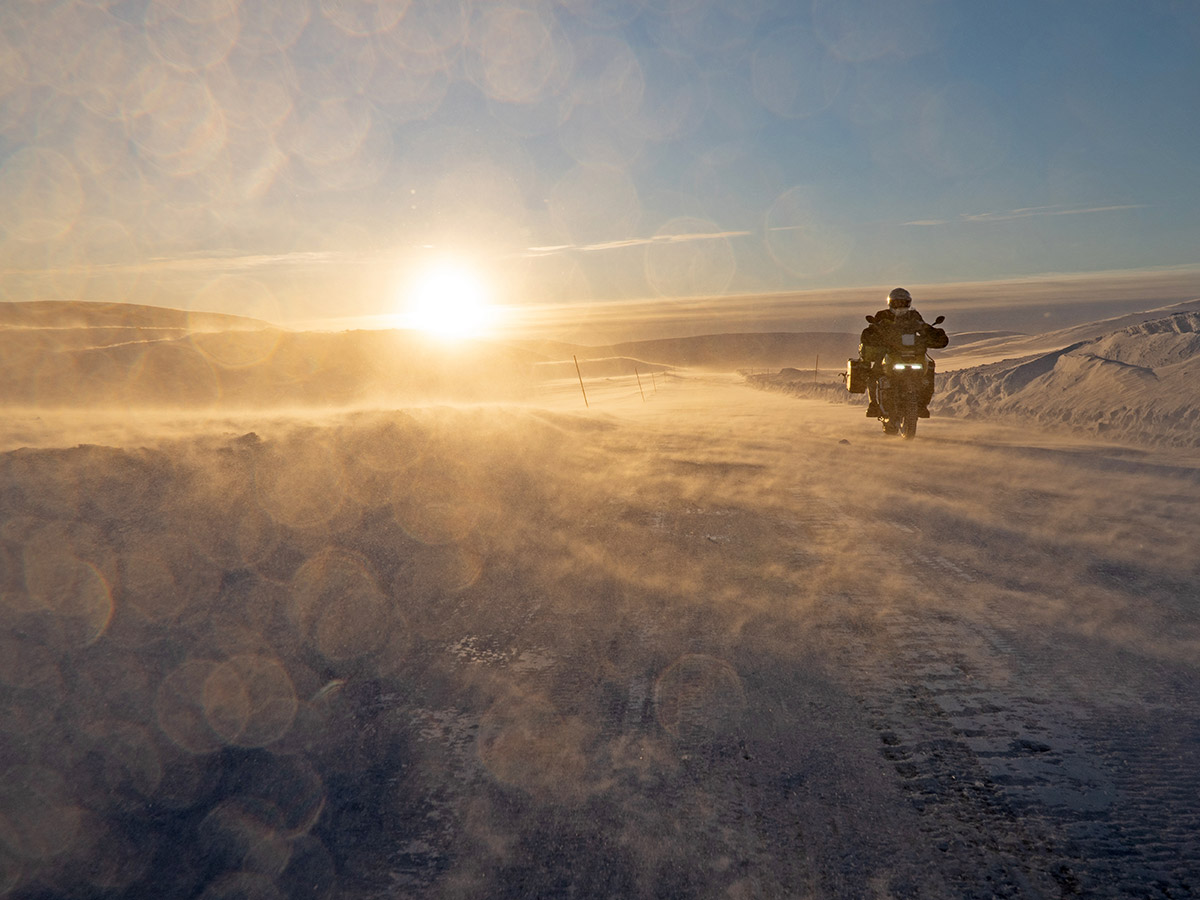 In February, the sun only just makes it above the horizon
In February, the sun only just makes it above the horizon
The low sun projects warm colours onto the snow
Rainer and I are up early the next morning. The weather forecast, which is under our permanent observation, predicts only a small window of sunshine, the next storm low has already announced its arrival in the early afternoon.
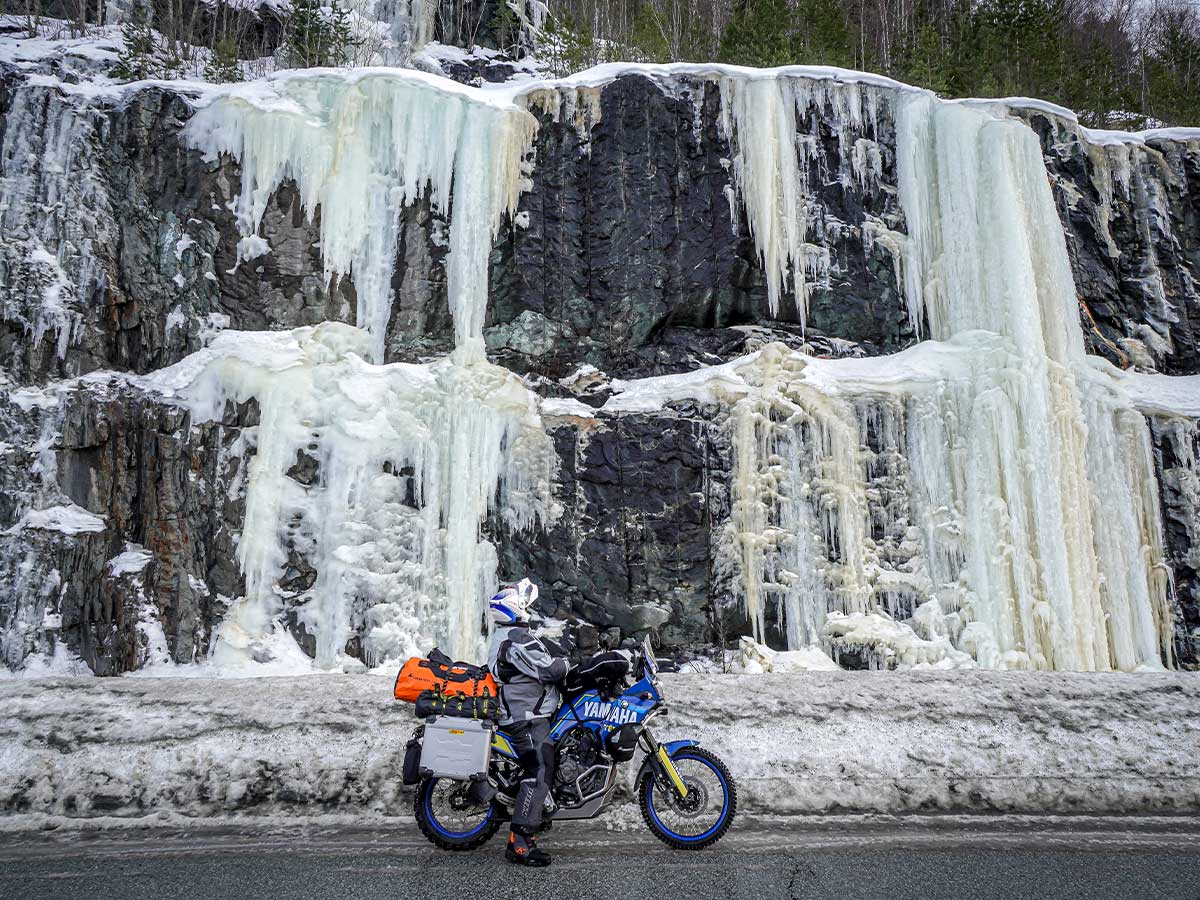 When waterfalls freeze, they freeze into bizarre shapes
When waterfalls freeze, they freeze into bizarre shapes
The barrier at the junction is open, meaning the way to the North Cape is clear. We drive through a wildly romantic winter landscape and enjoy the warm colours projected onto the snow by the low sun. Up on the plateau a stiff wind is already blowing. The northern end of Europe is ours alone right now, so it's not a good idea to let the engines get cold. Astride our two adventure bikes we head straight for the sphere. There's nowhere in the world you can get further north with your own vehicle than that.
The wind is getting up. We enjoy another coffee and delicious blåbær kake (blueberry pie) before heading south again. When we arrive in Honningsvåg, the storm has already reached hurricane force. At the hotel, we still confidently plan the next day, map out tomorrow's destination, and then enjoy the gastronomic possibilities of the small town.
The next morning. It's impossible to continue our journey. The roads are covered with snow; even in convoy it wouldn't be possible. According to the forecast on our traffic app, we'll have to stay on Magerøya for at least two days. In the end, three more days pass before we can head south again.
We stay at the northernmost Harley club in the world
Alta has just finished the blue season. Between mid-November and early January, the sun doesn't rise in this place; what the 12,000 inhabitants of the small town see instead of the sun during this time is the dark blue of the sky. We stay at the Bunkers. The members call their club the northernmost Harley-Davidson club in the world. The Pan America is being intensively appraised. The guys are clearly interested in the Adventure Bike variant from Milwaukee, but they invariably prefer the classic editions of American motorcycle engineering. While the Pan America is allowed to spend the night together with us in the warm workshop, my Ténéré has to stay outside. My little Japanese lady doesn't mind, and starts up – as usual – after a cold night with temperatures around minus 15 degrees Celsius, at the first push of the button.
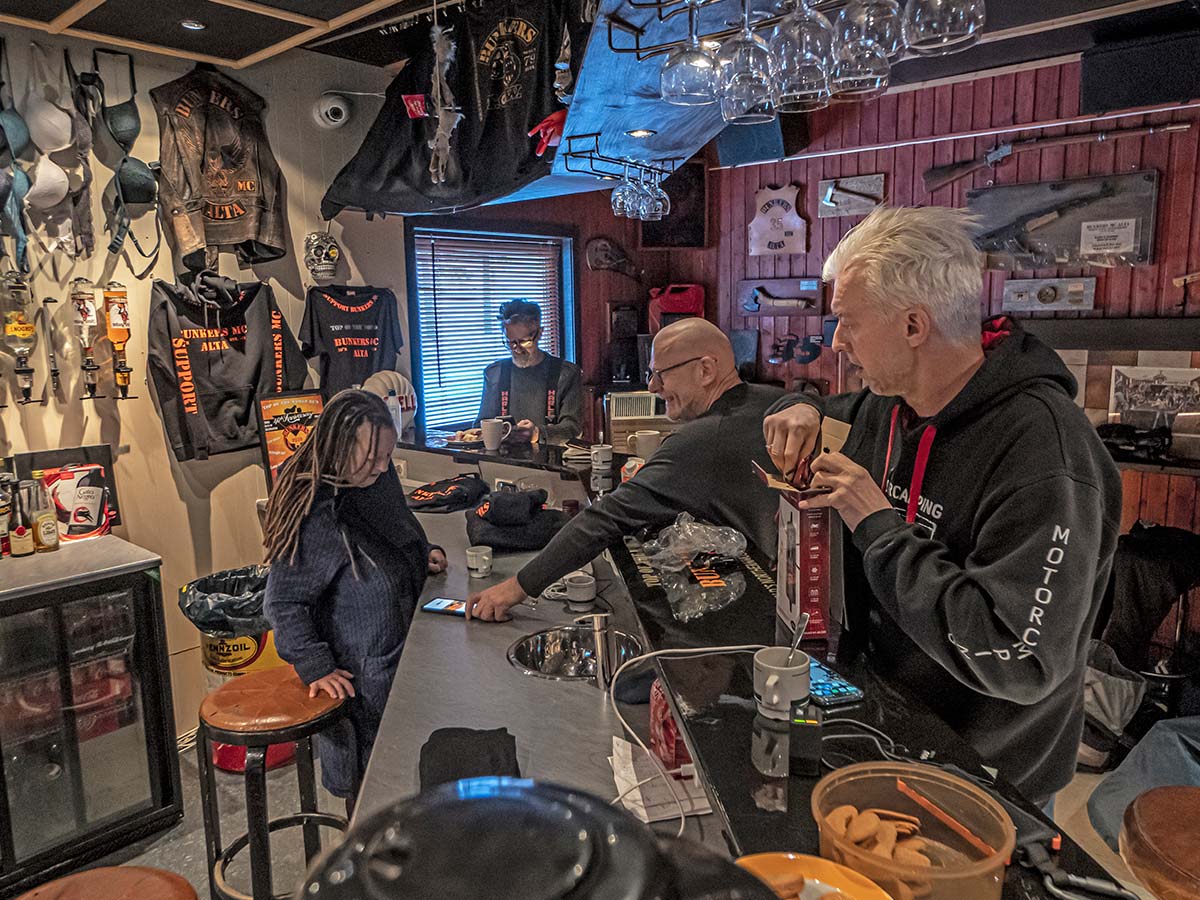 Visit to the "Bunkers" in Alta, the northernmost Harley club in the world
Visit to the "Bunkers" in Alta, the northernmost Harley club in the world
Rainer and I set our sights on Tromsø. I read in a brochure about the city that it's so special it can change people. Its location on the shores of the Arctic Ocean, the Arctic Ocean Cathedral, the Polar Museum: there's a lot in Tromsø that catches the visitor's interest.
The prospect of a celestial spectacle in the city drives us on. Our aurora app predicts the best chances of seeing the northern lights for the coming night. And indeed, outside the city, a fierce solar wind is blowing, conjuring dancing green and pink lights in the night sky. Scandinavian countries such as Iceland, Sweden, Finland and Norway, fight over who has the best light show, with Tromsø becoming something of an aurora borealis capital in this dispute.
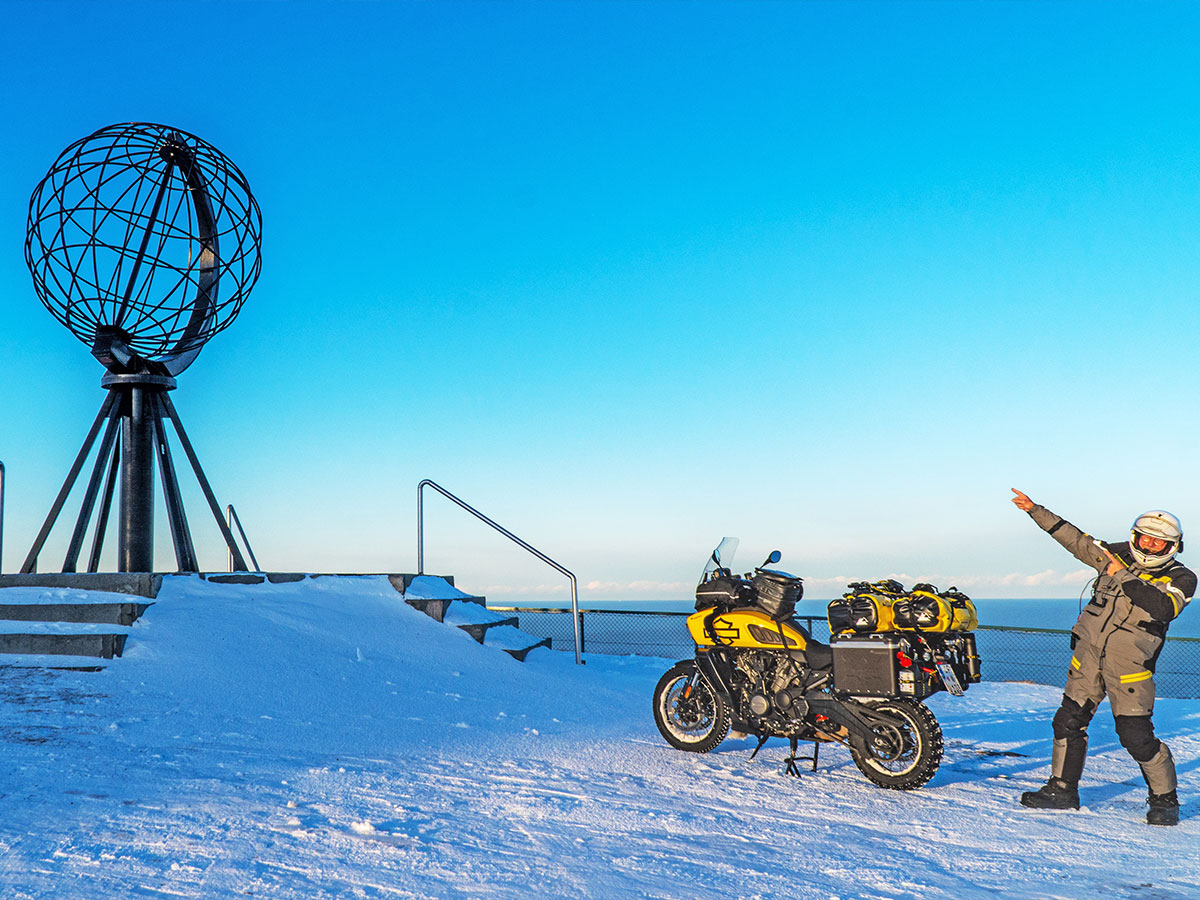 Done: we've reached coordinates 71° 10′ 21″ North, 25° 47′ 4″ East
Done: we've reached coordinates 71° 10′ 21″ North, 25° 47′ 4″ East
A stormy low nails us down in Lofoten
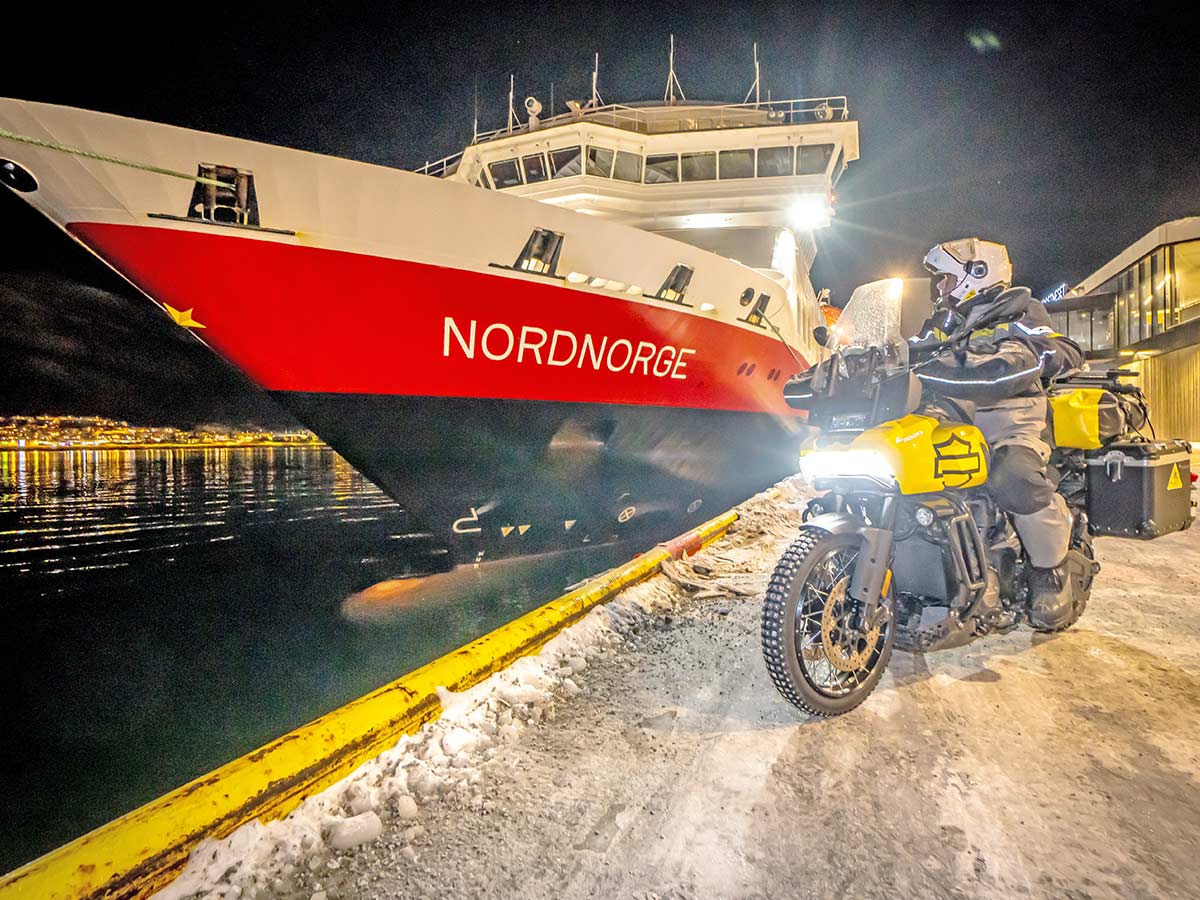 From Tromsø, we set off to the Lofoten Islands on board the "Hurtigruten"
From Tromsø, we set off to the Lofoten Islands on board the "Hurtigruten"
We set our sights on our next destination, Lofoten. The weather reports are not very friendly as far as this region is concerned. So why not avoid the bad weather and sail to the archipelago with the Hurtigruten. We set off in the middle of the night, the "Nordkap" will be mooring at the quay in Tromsø at one o'clock. The journey takes a whole day. It's the middle of the night again when the ferry spits us out at Svolvær harbour.
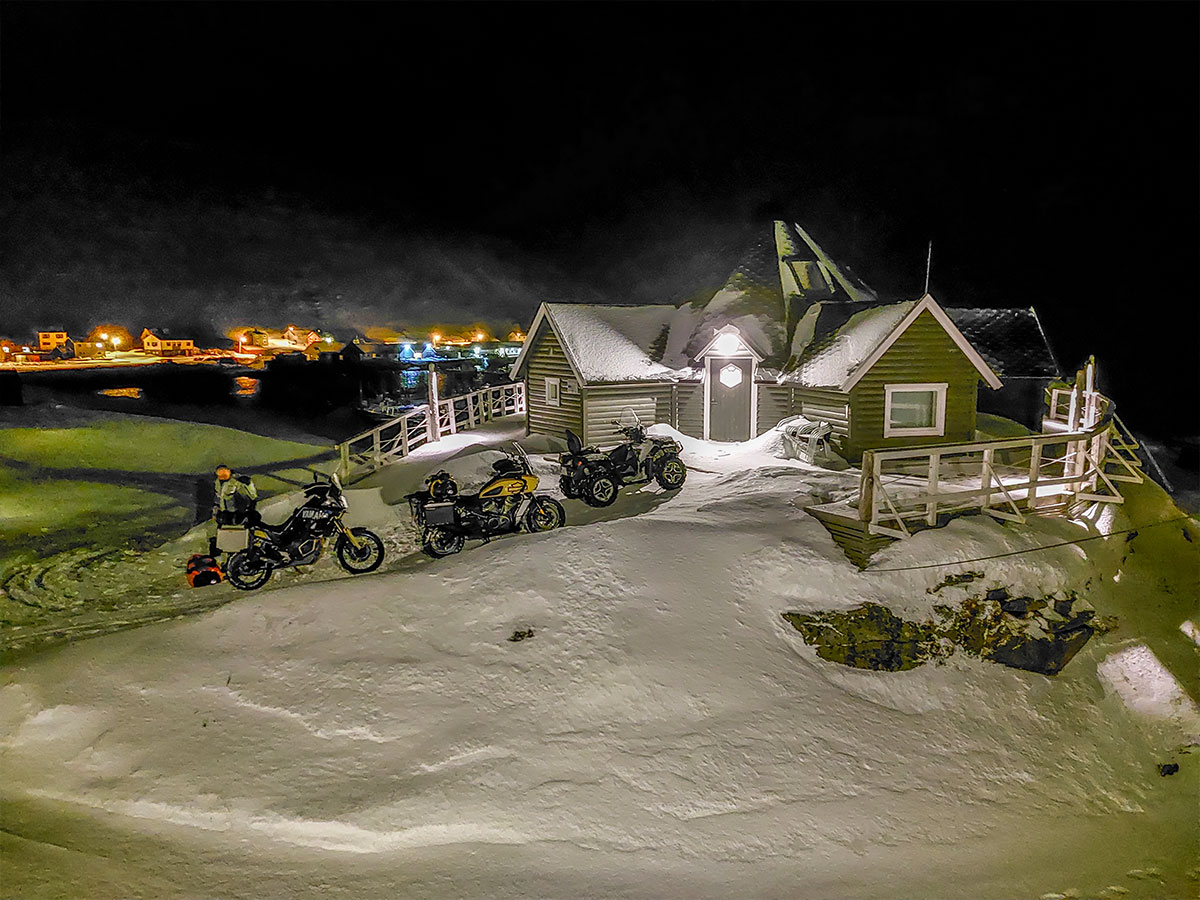 Lucky: we find shelter in the night snowstorm
Lucky: we find shelter in the night snowstorm
Another storm keeps us captive in the town, and any attempt to explore some of Lofoten's scenic attractions is thwarted by heavy snow flurries. Nusfjord and Reine are places worth seeing, but they remain inaccessible to us due to the snow storm. We just manage the 25 kilometres to the fishing village of Henningsvær. Rainer and I realise we really have to get off the archipelago, because the weather is likely to get worse rather than better in the coming days. We do some research on the internet and the lady at the reception also does her best to help us. Finally, we know for sure that the ferry from Moskenes to Bodø is going to leave tomorrow – if the storm doesn't get any more violent.
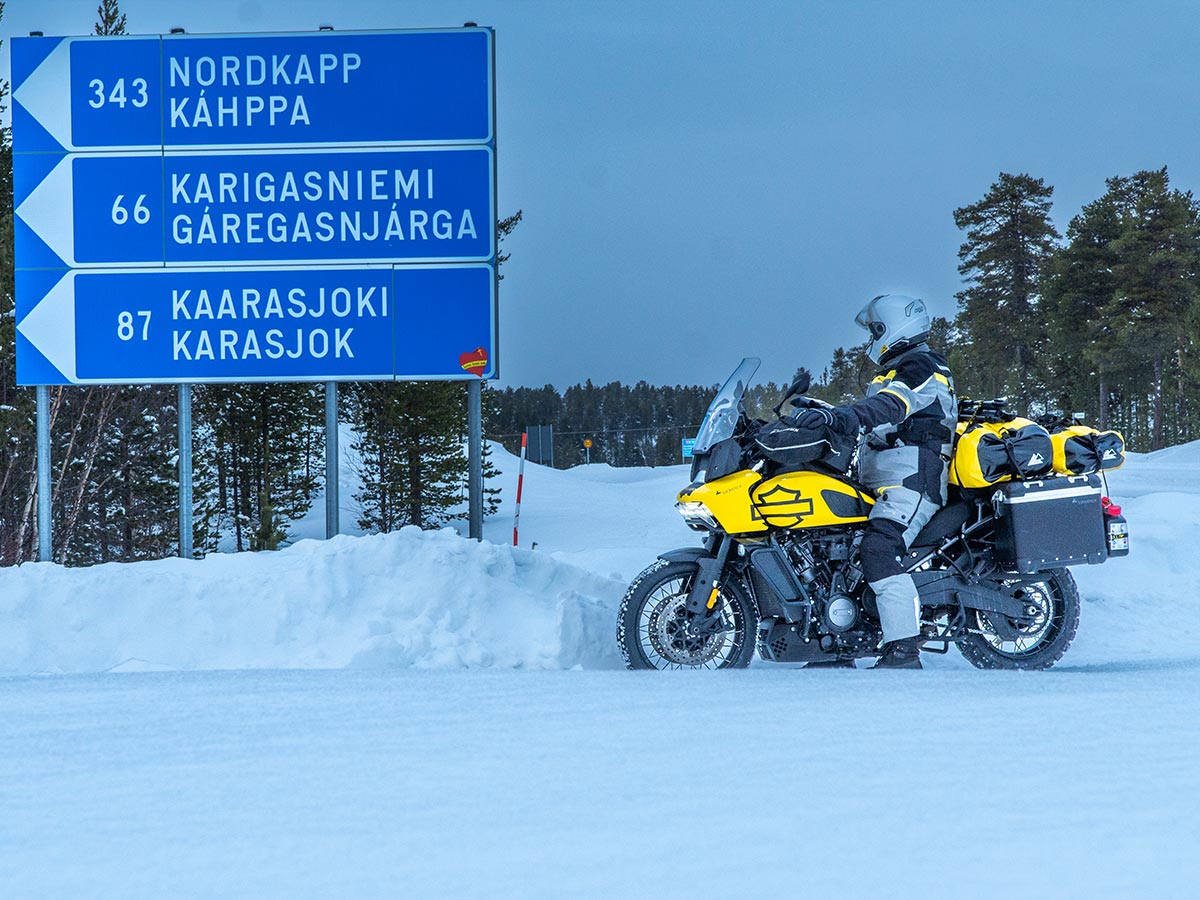
In summer it's only a one-day journey, but in winter it takes much more time to cover the distance from Inari to the North Cape
We are up early so as not to miss the ferry. However, we don't get very far on this day. We've only been on the road for a few kilometres when the Harley suddenly conks out. The engine stops and won't start again.
Ahead of me lies a winter solo ride of 1700 kilometres
A few hours later, the Pan America is in a workshop. The mechanic's verdict is sobering: he reckons that, here in Lofoten, it will certainly not be possible to repair the motorcycle in the foreseeable future. Rainer will have to continue his return journey by plane. And I have a solo ride of almost 1700 kilometres ahead of me.
These turn out not be entirely storm-free either. Again and again I have to deal with road closures on the E6. The reasons are always the same: too much snow, or the wind is so strong that it's blown yet another truck off the road. Rainer has already been home for a long time when, after a few detours, I reach the port of Malmö and the "Finntrader" takes me back to Germany.
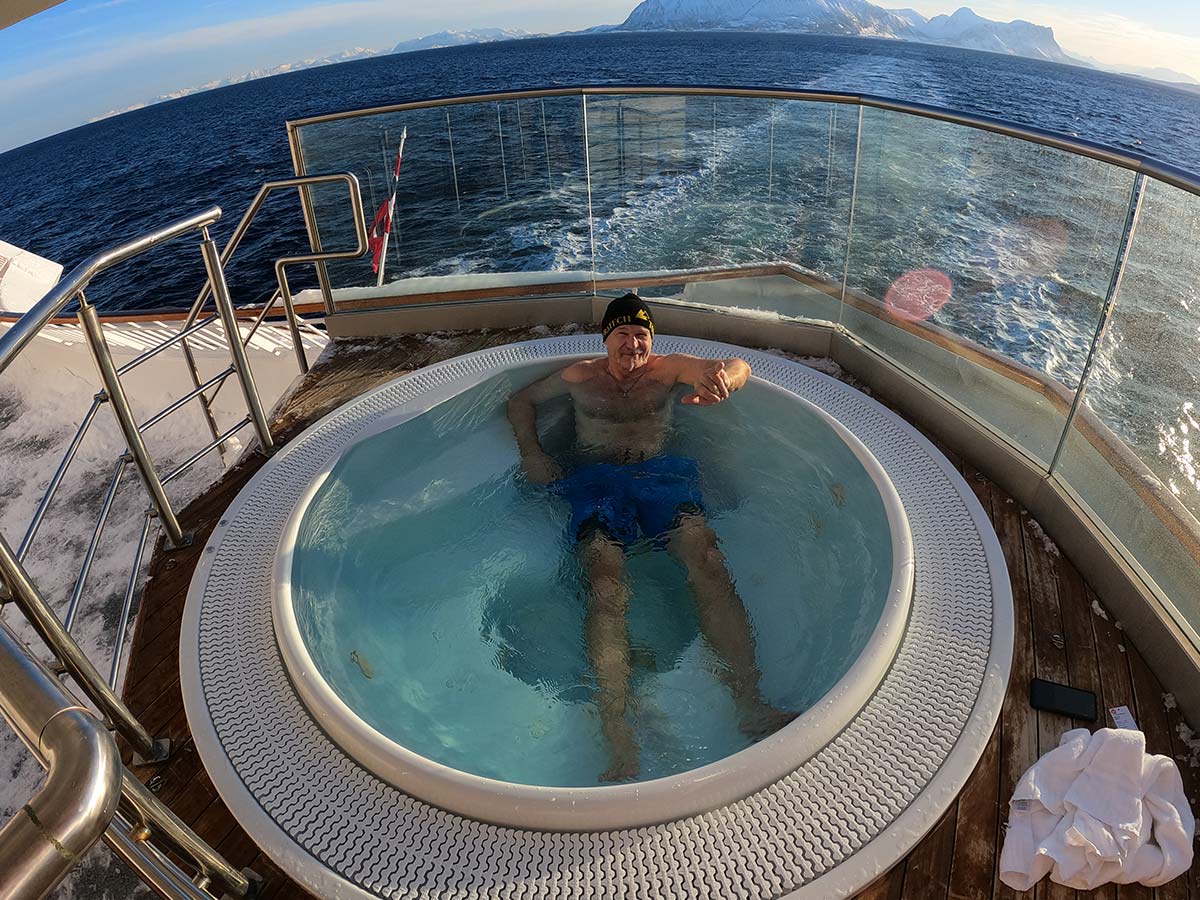
The "Nordnorge" offers relaxation even at 12° Celsius
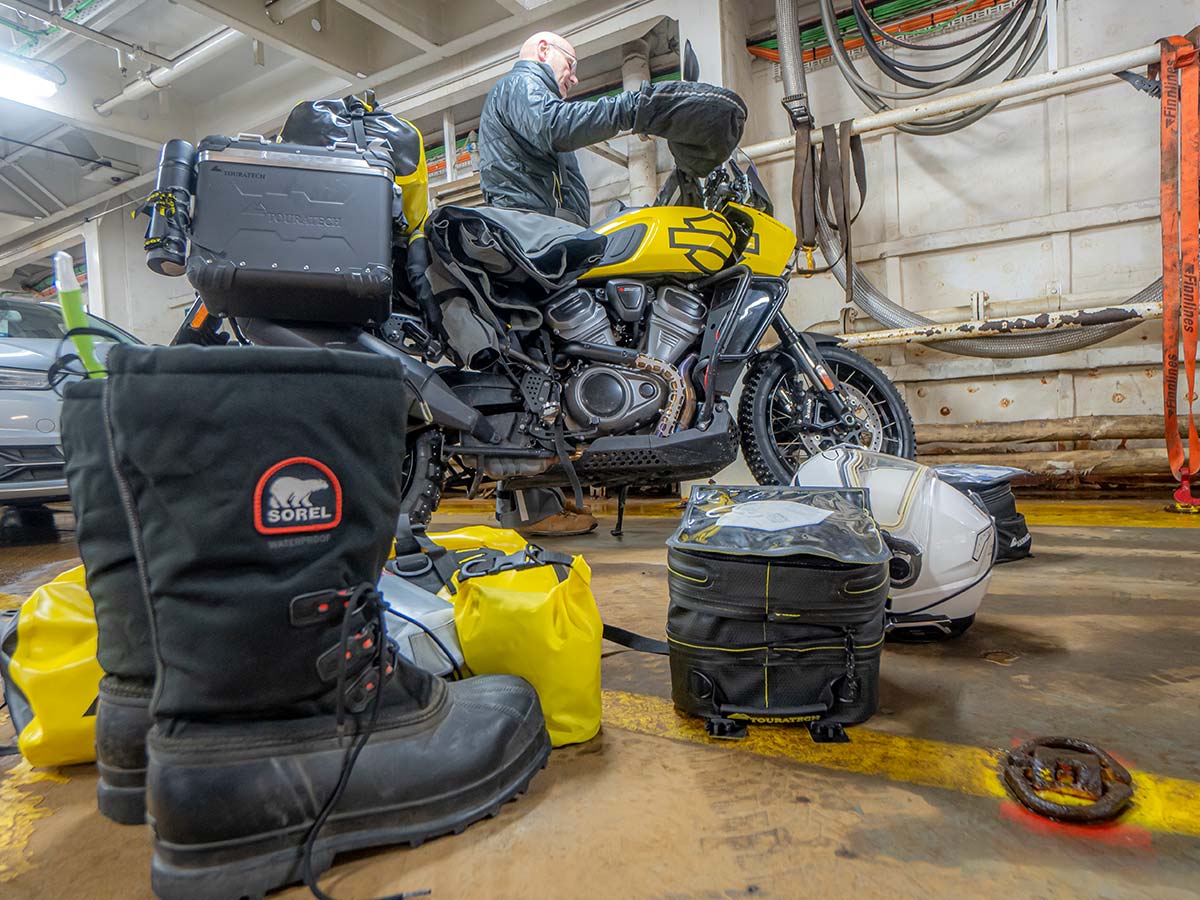
Clear to cast off: lashing the motorcycles on the Finnlady
Travel information
Arrival
A quick and warm way to reach the Arctic Circle is to combine ferry and car train. Finnlines offers a daily ferry service from Travemünde to Helsinki. The crossing takes 29 hours. Departure 3.00 am – the ferry arrives in Helsinki around 9.00 am the following day.
From the Finnish capital, it's possible to continue to Rovaniemi by car train on the same day. The train departs in the evening and reaches its destination the next morning at around 8.00 am.
Travelling by Finnlines ferry and car train is also a good alternative for a trip to the Arctic Circle or North Cape in summer. This combination saves almost 1400 kilometres and quite a few days compared to the journey on the road via southern Sweden.
Climate and travel time
If you want to see the aurora borealis, you don't necessarily have to travel to Scandinavia in the winter. As soon as darkness returns to the far north, there is a chance of seeing the northern lights in the night sky. Temperatures range between 15 degrees Celsius and freezing point in spring and autumn. Winter has a lot to offer. One of the highlights is certainly a ride through the snow-covered forests. Temperatures can also drop to well below freezing at this time of year. At night, minus temperatures in the double-digit range are not uncommon. The long hours of darkness should also not be underestimated. Depending on the month, there is no daylight at all north of the Arctic Circle, or only for a few hours.
Motorcycling in winter
In northern Scandinavia, the roads are covered with ice and snow in winter, which makes the use of spikes necessary. In this context: the more the better. On the Ténéré, as on the Pan America, about 500 spikes were fixed into each tyre. In Germany, these steel spikes are banned, which means that the motorcycle has to be transported to the ferry on a trailer.
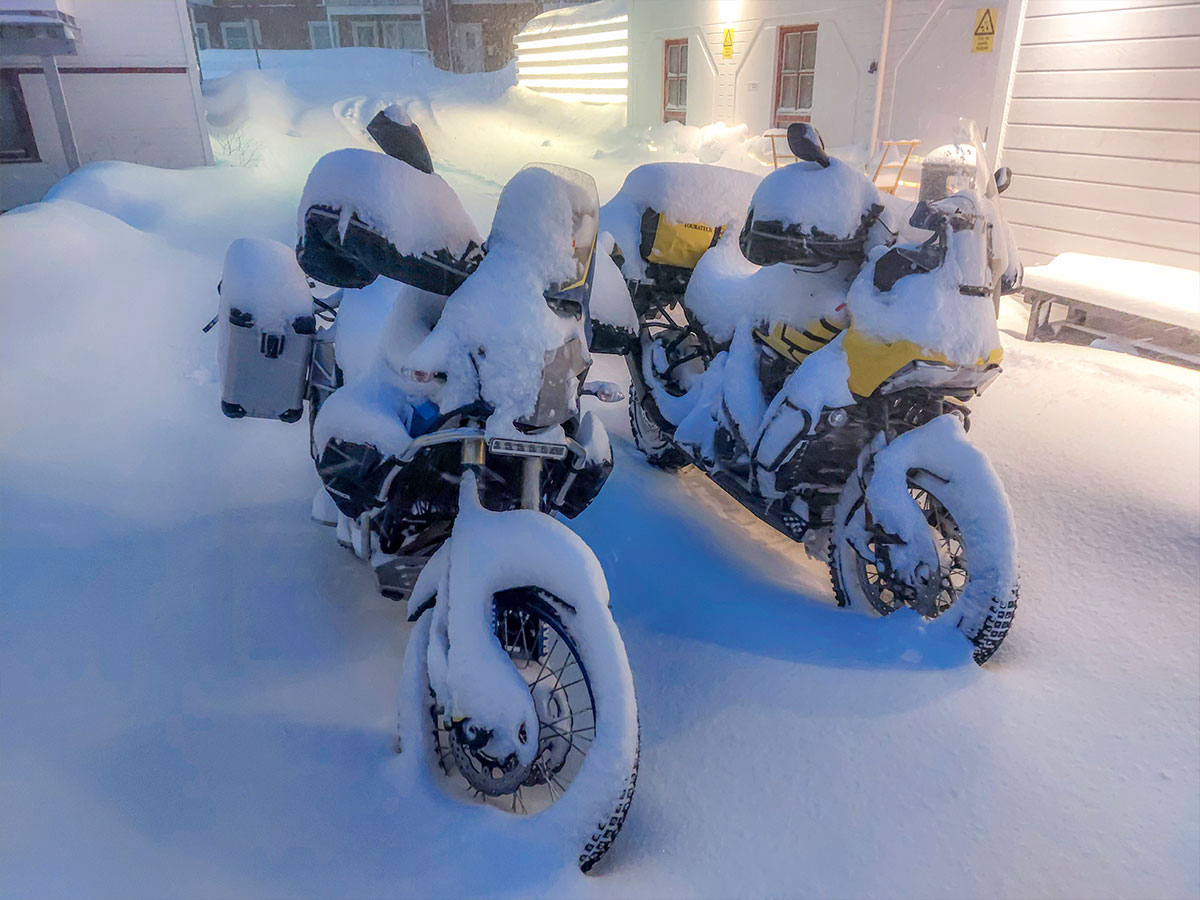
Handlebar gauntlets and warm boots are also part of the basic equipment for winter travel. When it comes to clothing, there are countless ways to keep warm. The principle of layering has proved to be most effective, starting with functional underwear and finishing with thermal suits. Rainer Krippner from Touratech Kassel had very good results with the Compañero Rambler on this tour.
Accommodation
It's in the nature of things that many campsites are closed from autumn until spring. But when you're on the road, there's often the possibility of renting a cabin. We found a warm welcome and cabins at a good price near Orsa (Rosentorp). Caroline and Daniel, who run Sandsjögården, are also very friendly people. The price for cabins ranges from 50 to 100 euros per night, depending on size and facilities. Hotels offer rooms for about 100 euros per night, breakfast is usually included.
Money and papers
Your identity card, as well as driver's licence and vehicle registration certificate are obligatory. You should also pack a green insurance card. Credit and debit cards are also important, as cashless payment is becoming increasingly popular in Scandinavia. Quite a few petrol stations now only offer card payment.












